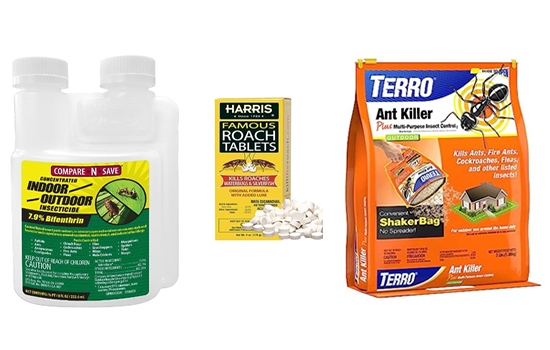Pests like ants, roaches, mice, and other critters can be a nuisance in your home. Calling an exterminator every time you see one can get expensive. With a few simple, low-cost solutions, you can take pest control into your own hands and keep your home free of unwanted visitors.

Buy Concentrate Pest Killer
One of the most economical ways to control household pests is to buy concentrated pesticides and dilute them yourself. This allows you to make gallons of finished spray for a fraction of what pre-mixed products cost.
Bifenthrin is an inexpensive, over-the-counter pesticide that kills hundreds of different insects. It comes concentrated as a liquid that you mix with water. A 32 oz bottle sells for around $30 online or at farm supply stores. Follow the label to dilute it into a gallon of ready-to-use spray. One bottle makes up to 100 gallons, so you’ll have pest spray for years to come at a cost of around 30 cents per gallon.
You’ll also need a one gallon garden sprayer, which you can find for $15-$20. Use it to spray the diluted bifenthrin around baseboards, under appliances, and other places bugs hide. This treatment will kill ants, cockroaches, spiders, and many other common pests. Reapply every few months for continued control.
Set Out Ant Killer Baits
Outdoor ant mounds and indoor ant trails can be frustrating problems. A simple fix is ant killer bait stations. These contain a sweet bait plus a pesticide that worker ants take back to the nest and feed to the queen, wiping out the entire colony.
Outdoor stakes like Amdro Kills Ants run under $10 for a package of 6 to 12. Place them near mounds and along areas where ants enter the house. Indoor ant baits like Terro Liquid Ant Killer run about $5 per bait. Put them along countertops, windowsills, anywhere you see ants. Replace every few months.
The active ingredient in most ant baits is either borax or abamectin. The store brand versions work just as well as name brands for a lower cost.
Apply Cockroach Killer
Scuttling cockroaches can make your skin crawl. Get rid of them with cockroach bait stations similar to ant baits. Harris Roach Tablets are some of the most effective and cost less than $10 for a box containing 145 tablets.
Put the tablets in the back of cabinets and drawers, under appliances, and anywhere else cockroaches like to hide. The bait will kill roaches that eat it plus any others they expose when returning to the nesting area.
You can also spray diluted bifenthrin in these areas for added roach control. Be sure to hit cracks and crevices where they hide.
Set Out Mouse Traps
Mice may be small, but they can damage your home and spread disease. Stop them in their tracks with inexpensive mouse traps. A 6-pack of basic snap traps costs around $5.
Place traps wherever you see signs of mice like droppings, gnawed items, or along baseboards and walls where they travel. Use peanut butter for bait. Check and rebait the traps every 1-2 weeks to catch any invading mice before they breed and multiply.
For a mess-free option, opt for live catch traps that trap mice humanely so you can release them outdoors. They cost a little more, around $10-12 each, but let you relocate mice without killing them.
Seal Cracks and Gaps
Pests need open access points to enter and move around your home. Sealing cracks shuts down their highways. Spend an afternoon sealing any openings wider than 1/4 inch, especially where utilities enter the home.
Caulk, expandable foam, weatherstripping, and other sealants cost between $3-$8 per tube. Target plumbing penetrations, gaps around windows and doors, attic entrances, and any crevices along the foundation or siding that could be mouse or insect entryways.
Sealing the exterior keeps new pests from getting in, while sealing the interior keep current pest infestations contained until other treatments like traps and sprays can work.
Clear Debris and Manage Food Sources
Pests won’t hang around if they can’t find food and shelter. Make your landscaping and home exterior less inviting with some DIY maintenance:
- Clear leaves, grass clippings, firewood, and other debris that pests use for hiding and breeding.
- Trim bushes and vegetation back from the house.
- Pick up fallen fruit and vegetables from gardens.
- Store outdoor cushions and pillows inside when not in use.
- Fix leaky faucets and pipes.
- Clean up pet food and water bowls at night.
- Seal trash cans and keep trash storage areas clean.
- Compost food waste in closed bins, not open piles.
By removing pest habitat and food sources, you force them to look elsewhere for a home. No need to use pesticides if they aren’t interested in sticking around anyway!
Know When to Call a Professional
While you can control many occasional invaders yourself, some large-scale pest infestations require professional treatment:
- Termite swarms emerging from your home require termite treatment.
- A bee or wasp hive growing under the eaves needs removal and exclusion.
- An active rodent infestation with dozens of mice or rats calls for more powerful rodenticides and bait stations.
- A carpet beetle or clothes moth infestation may take fumigation to clear.
DIY pest control works great for maintenance. But call the pros for severe or structural pest issues. Getting exterminators involved earlier rather than later will minimize damage to your home.
Use these affordable pest prevention tips and products to tackle minor pest problems yourself. With diligence and proper application, you can keep your home free of most unwelcome visitors and save hundreds of dollars yearly on exterminator fees. A small investment of time and money goes a long way when controlling pests in your living space.
